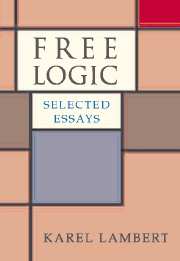Book contents
- Frontmatter
- Contents
- Introduction
- 1 Russell's Version of the Theory of Definite Descriptions
- 2 Existential Import, ‘E!’ and ‘The’
- 3 The Reduction of Two Paradoxes and the Significance Thereof
- 4 The Hilbert-Bernays Theory of Definite Descriptions
- 5 Foundations of the Hierarchy of Positive Free Definite Description Theories
- 6 Predication and Extensionality
- 7 Nonextensionality
- 8 The Philosophical Foundations of Free Logic
- 9 Logical Truth and Microphysics
9 - Logical Truth and Microphysics
Published online by Cambridge University Press: 05 June 2012
- Frontmatter
- Contents
- Introduction
- 1 Russell's Version of the Theory of Definite Descriptions
- 2 Existential Import, ‘E!’ and ‘The’
- 3 The Reduction of Two Paradoxes and the Significance Thereof
- 4 The Hilbert-Bernays Theory of Definite Descriptions
- 5 Foundations of the Hierarchy of Positive Free Definite Description Theories
- 6 Predication and Extensionality
- 7 Nonextensionality
- 8 The Philosophical Foundations of Free Logic
- 9 Logical Truth and Microphysics
Summary
LOGICAL TRUTH AND TRUTH-VALUE GAPS
Elementary microphysical statements can be neither true nor false without violating the classical codification of statement logic. The existence of such a possibility depends upon a revision in the standard explication of logical truth, a revision more harmonious with the idea of argument validity as merely truth-preserving. The revision in question, in turn, depends upon Bas van Fraassen's investigations into the semantical foundations of positive free logic, a species of logical system whose philosophical significance was first made plain in Henry Leonard's pioneering study of 1956, ‘The Logic of Existence’.
Students who steadfastly refuse to accept an argument as valid unless all of the component statements are in fact true frustrate teachers of logic. “Now look!” the teacher may heatedly emphasize, “the validity of an argument has to do with its form alone. So to say that an argument is valid is to say only that if its premises were true its conclusion would also be true!” But, then, not only is the argument from the pair of false statements
Jim Thorpe was Russian
and
If Jim Thorpe was Russian, he was a Bolshevik
to the false statement
Jim Thorpe was a Bolshevik
valid, but so is the argument from the pair of (allegedly) truth-valueless statements
The Queen of the United States dreamed she was being led down a bridal path by a gorilla
and
If the Queen of the United States dreamed she was being led down a bridal path by a gorilla, she desires to marry a man named ‘Harry’
to the (allegedly) truth-valueless statement
The Queen of the United States desires to marry a man named ‘Harry’.
Information
- Type
- Chapter
- Information
- Free LogicSelected Essays, pp. 176 - 191Publisher: Cambridge University PressPrint publication year: 2002
